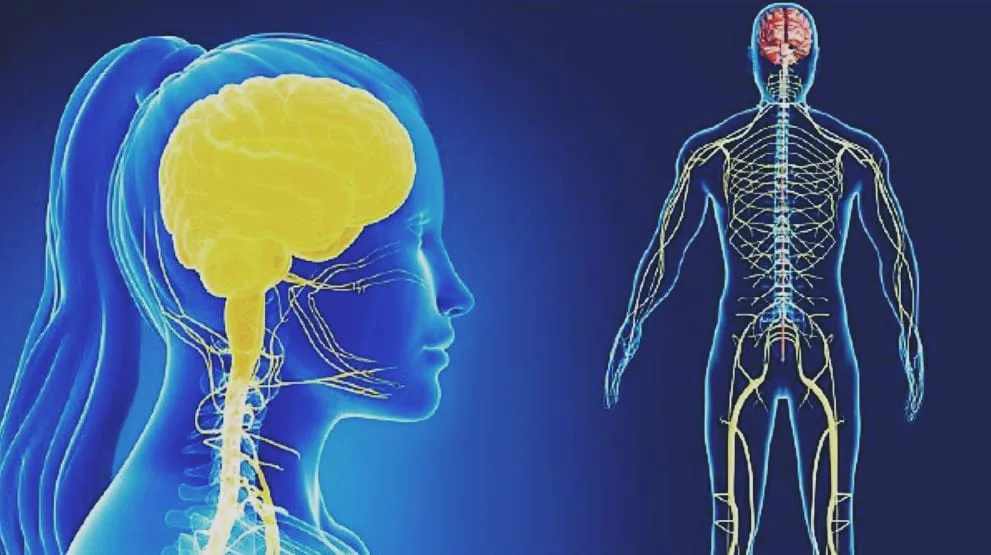Types of Nervous Systems: Central vs. Peripheral
The nervous system is a complex web of nerves and cells that relays information between the brain and spinal cord and numerous body components. It comprises of;
- Central Nervous System
- Peripheral Nervous System

Central Nervous System
The brain and spinal cord make up the CNS. It is the body’s processing center. The majority of bodily processes, including consciousness, movement, thought, speech, and the five senses of sight, hearing, feeling, taste, and smell, are controlled by the brain.

The Brain
The mushroom-shaped brain resides inside the skull. It is divided into four main sections:
- Cerebrum
- Cerebellum
- Brainstem
- A diencephalon
The average brain weighs between 1.3 and 1.4 kg. It consists of neurons, which are nerve cells, and glia, which are support cells.
Gray matter and white matter are the two different forms of matter that make up the brain. It receives and stores impulses in the gray matter. ).
1. Brain Stem
It is approximately one inch in length and situated between the pons and the spinal cord.
2. Cerebrum
The brain stem serves as support for the cerebrum, which makes up the majority of the brain. Two hemispheres make up the cerebrum. The activities of the side of the body opposing each hemisphere are controlled by that hemisphere.
3. Cerebellum
This is situated below and behind the cerebral cortex. Over 50% of the brain’s total neurons are found in the cerebellum, although it makes up just about 10% of the brain’s overall volume.
4. A diencephalon
The thalamus and hypothalamus are parts of the diencephalon. Where sensory and other impulses congregate in the thalamus.
The diencephalon includes a smaller portion called the hypothalamus.
Spinal Cord
From the brain, the spinal cord emerges as a long, tube-like structure. The spinal cord consists of 31 separate segments. Each segment has two spinal nerves coming out of it.
The spinal segment is the area of the spinal cord from which a pair of spinal nerves emerge. The spinal cord houses both motor and sensory nerves.
In adults, the spinal cord measures about 43 cm in length for women and 45 cm for men, and it weighs between 35 and 40 gm. It is located within the vertebral column, a group of bones (backbone).
Peripheral Nervous System(PNS)
Outside of the brain and spinal cord, the Peripheral Nervous System comprises of the nerves and ganglia. The primary job of the PNS is to convey information between the brain and spinal cord and the rest of the body via connecting the CNS to the limbs and organs.
The peripheral nerve system consists of two distinct components.
- Somatic Nervous System
- Autonomic Nervous System
Somatic Nervous System
It consists of peripheral nerve fibers that collect sensory data or sensations from peripheral or distant organs (organs not connected to the brain, such as limbs) and then transmit those data or sensations to the CNS.
Additionally, they consist of motor nerve fibers, which leave the brain and convey instructions for movement and taking essential actions to the skeletal muscles.
The entire process is completed in under a second. The information-carrying neuron’s cell body frequently resides in the brain or spinal cord and sends signals straight to the skeletal muscles.
Autonomic Nervous System (ANS)
Another part of the PNS is the Autonomic Nervous System. It has three parts:
- The sympathetic system
- The parasympathetic system
- The enteric nervous system
When facing emotional stress or physical danger in a “fight or flight” scenario, the sympathetic system is triggered.
The parasympathetic system enables the body’s “rest and digest” mode of operation.
The third component of the ANS is the enteric nervous system. The digestive system, pancreas, gall bladder, and other organs of the abdomen are all innervated by the enteric nervous system, which is a sophisticated network of nerve fibers.
For Further Reading:

